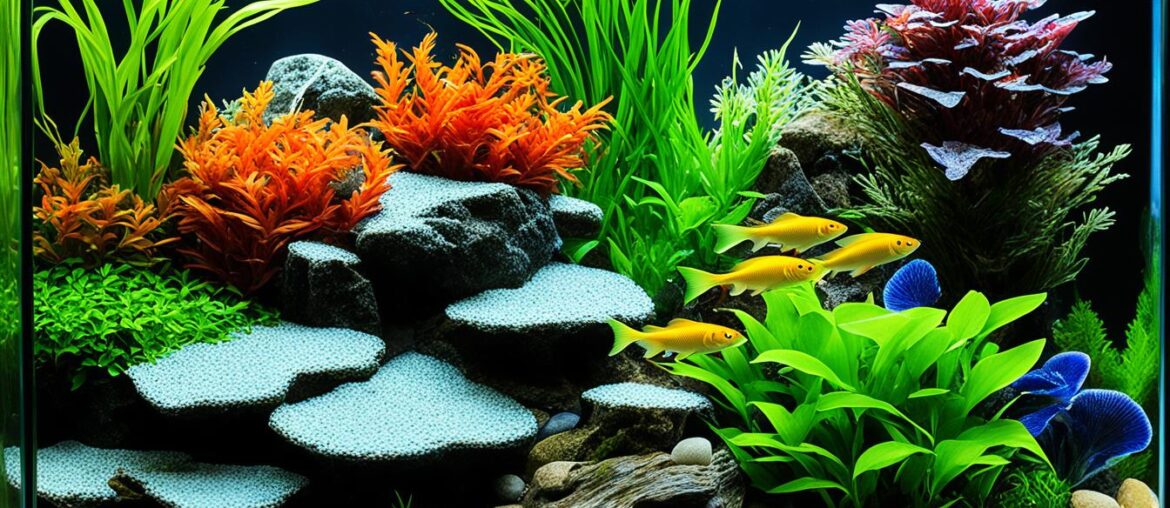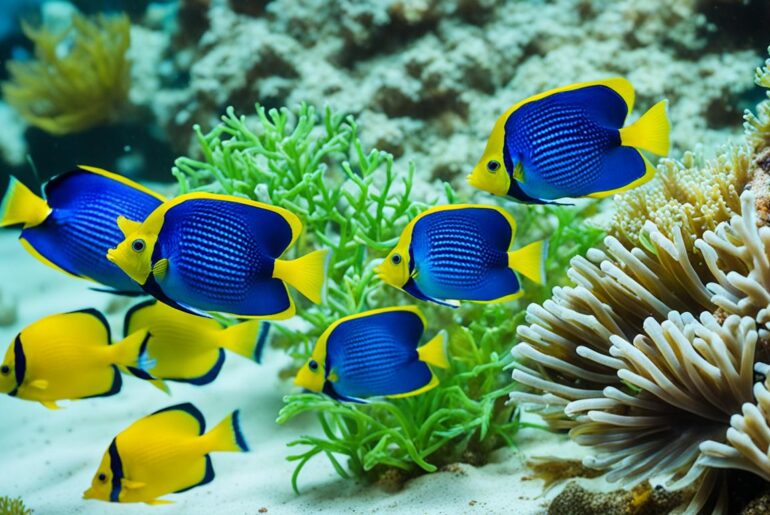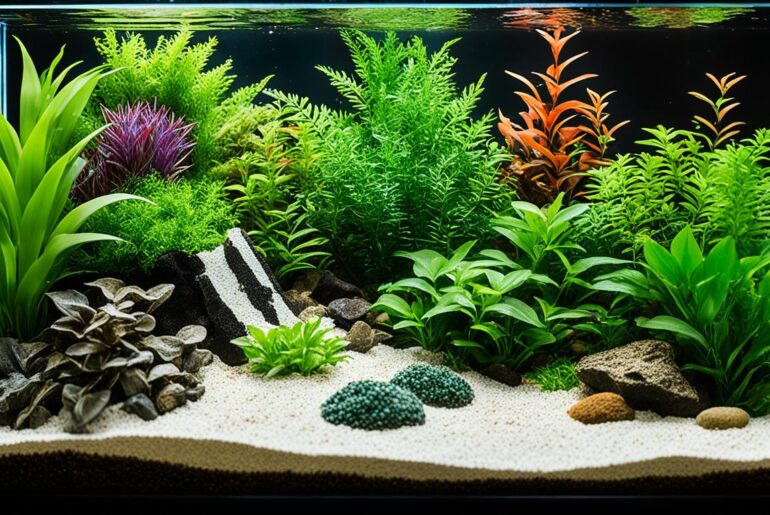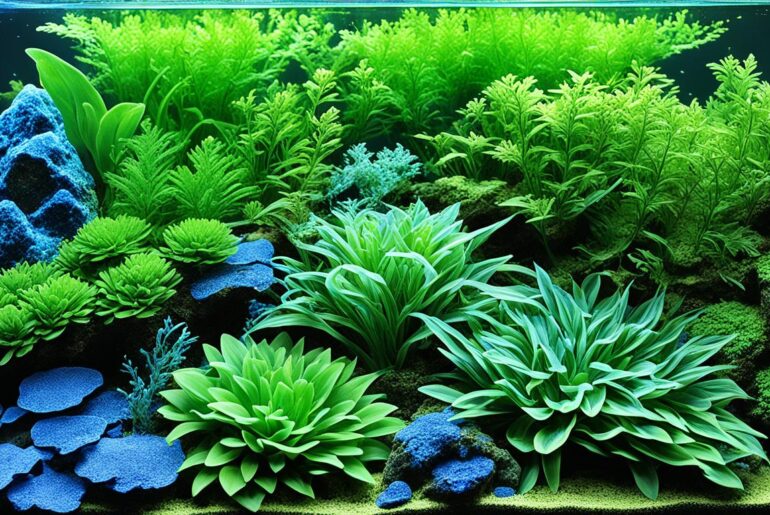Have you ever stared into the serene depths of a freshwater aquarium, marveling at the vibrant fish and lush aquatic plants? For me, it’s a moment of peace and tranquility, a reminder of the incredible beauty that exists within nature’s delicate balance. But as a responsible aquarium owner, I also know that this beauty relies on careful consideration of every element that goes into creating a thriving underwater ecosystem.
One crucial aspect of setting up a freshwater aquarium is choosing the right substrate. The substrate not only serves as a foundation for your aquarium layout but also plays a vital role in the health and well-being of your fish and plants. It’s a decision that shouldn’t be taken lightly, as the wrong choice could have disastrous consequences. As someone who has learned through trial and error, I want to share my knowledge with you, guiding you towards safe substrate options that will help you create a perfect habitat for your aquatic friends.
Before we dive into the specifics, let’s take a moment to understand the factors that make substrate selection critical. Fish species have different preferences and requirements when it comes to their underwater environment. Some may need a softer substrate to protect their delicate skin, while others thrive in an environment with specific pH levels. Additionally, if you have live plants in your aquarium, they rely on the substrate for nutrients and anchoring their roots. By considering these factors and making informed choices, you can create a harmonious aquarium ecosystem that brings joy and beauty to your everyday life.
Key Takeaways:
- Choosing the right substrate is crucial for the health and well-being of your fish and plants.
- Fish species have different preferences and requirements, so it’s essential to consider their needs when selecting a substrate.
- Live plants rely on the substrate for nutrients and anchoring their roots, making the right choice vital for their growth.
- By making informed substrate choices, you can create a harmonious underwater ecosystem that brings joy and beauty to your everyday life.
- Stay tuned as we explore different substrate options and provide recommendations for creating a safe and thriving freshwater aquarium.
Gravel: A Popular Choice for Freshwater Aquariums
When it comes to selecting the perfect substrate for your freshwater aquarium, gravel is a top choice among aquarium enthusiasts. Not only does it provide a visually appealing aesthetic with its various colors and particle sizes, but it also offers practical benefits for maintaining a clean and healthy tank.
Gravel serves as an excellent substrate as it is easy to clean and maintain. Vacuuming the surface of the gravel allows for the removal of uneaten food and waste, ensuring a pristine environment for your fish. With its porous nature, gravel also helps to establish beneficial bacteria colonies that aid in biological filtration, promoting a balanced ecosystem within your aquarium.
However, when selecting gravel for your tank, it’s important to consider the needs of your fish. Opt for gravel with smooth edges to prevent any irritation to fish with delicate skin. While gravel is generally suitable for most fish species, it may not be ideal for bottom-dwelling catfish that prefer a smoother substrate.
Incorporating a nutrient-rich layer of aquarium soil under the gravel can be advantageous for planted tanks. The soil provides essential nutrients for optimal plant growth, creating a lush and vibrant underwater landscape. This combination of gravel and soil offers an ideal habitat for both fish and plants, striking a perfect balance between aesthetics and functionality in your aquarium.
Advantages of Gravel as a Substrate:
- Wide variety of colors and particle sizes
- Easy to clean and maintain
- Promotes beneficial bacteria colonies for biological filtration
- Provides a visually appealing aesthetic
Considerations When Using Gravel:
- Choose gravel with smooth edges to avoid irritation to fish with soft skin
- Not recommended for bottom-dwelling catfish
- Adding a nutrient-rich layer of aquarium soil under the gravel is recommended for planted tanks
Gravel is a versatile and popular substrate choice for freshwater aquariums, offering both practical and aesthetic advantages. By selecting the right gravel and incorporating it into your tank setup, you can create a beautiful and thriving underwater world for your fish and plants.
| Advantages of Gravel as a Substrate | Considerations When Using Gravel |
|---|---|
| Wide variety of colors and particle sizes | Choose gravel with smooth edges to avoid irritation to fish with soft skin |
| Easy to clean and maintain | Not recommended for bottom-dwelling catfish |
| Promotes beneficial bacteria colonies for biological filtration | Adding a nutrient-rich layer of aquarium soil under the gravel is recommended for planted tanks |
| Provides a visually appealing aesthetic |
Sand: A Natural and Easy-to-Clean Substrate
When it comes to creating a natural habitat for your fish, sand is an excellent substrate option for freshwater aquariums. With its different grain sizes and colors, sand provides a visually appealing and natural look to your tank. But not only is sand aesthetically pleasing, it also offers practical benefits for both fish and plants in your aquarium.
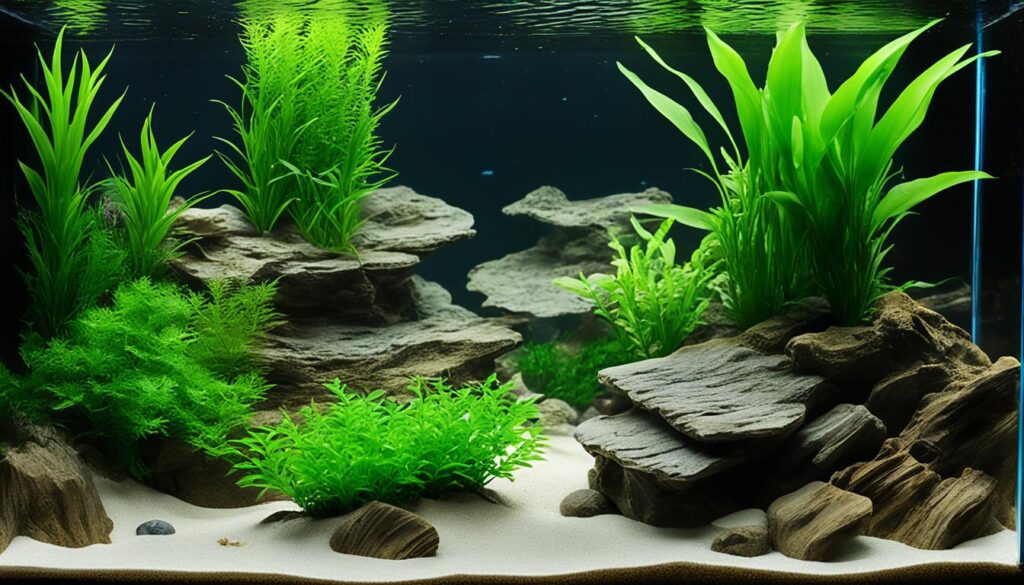
One of the main advantages of using sand as a substrate is its ease of cleaning. Unlike other substrates, sand does not trap debris, making it effortless to maintain a clean and healthy tank. With regular maintenance and a simple siphon, you can remove any excess food or waste that settles on the sand’s surface.
Benefits of Sand for Fish
Sand is particularly beneficial for bottom-dwelling fish species. Its fine texture provides a comfortable and natural environment for these fish to burrow and sift through the substrate. Examples of bottom-dwelling fish that thrive on sand include catfish, loaches, and certain species of cichlids.
Another advantage of sand is its compatibility with live plants. Sand allows plant roots to anchor effectively, promoting their growth and overall health. Whether you have a planted tank or want to incorporate a few aquatic plants, sand is the perfect substrate choice to create an ideal environment for plant life in your aquarium.
Mixing Sand with Other Substrates
One of the unique qualities of sand is its ability to be easily mixed with other substrates, giving you the freedom to create custom designs and unique styles for your aquarium. By combining sand with gravel or other materials, you can achieve various textures and colors, adding depth and visual interest to your tank.
“Sand is a versatile substrate that combines aesthetics, ease of cleaning, and compatibility with both fish and plants in your aquarium.”
Choosing the Right Aquarium Sand
When selecting sand for your aquarium, it’s crucial to choose a type that is specifically formulated for aquatic environments. This ensures that the sand is safe for your fish and won’t alter the chemistry or harm the delicate balance of the tank. Look for aquarium sand that is labeled as natural and suitable for freshwater aquariums.
Summary
Sand is a natural and easy-to-clean substrate option for freshwater aquariums. Its visual appeal, compatibility with bottom-dwelling fish and live plants, and versatility for custom designs make it a popular choice among aquarium enthusiasts. Just ensure to choose aquarium sand specifically formulated for aquatic environments to provide a safe and healthy habitat for your fish.
Soil: Perfect for Planted Tanks
Aquarium soil is the ideal substrate for planted tanks, providing a solid and stable foundation for aquatic plants to thrive. It offers a rich environment that promotes robust plant growth and often includes added nutrients to enhance their development. Available in natural brown colors, aquarium soil creates a lush and vibrant underwater landscape, creating a stunning visual centerpiece for your aquarium.
When choosing aquarium soil for your planted tank, it’s crucial to purchase it from reputable pet stores. Using soil or materials from your yard can introduce toxins and bacteria that may harm your fish. For the safety of your aquatic ecosystem, opt for specially formulated aquarium soil designed for underwater use.
Regular cycling and maintenance are essential for tanks with soil substrates. Cycling involves establishing the biological filtration system in the tank before introducing fish and plants. This process helps breakdown waste and balances the nitrogen cycle. In addition, periodic maintenance such as water testing and water changes ensure optimal water quality for your plants and fish to thrive.
Aragonite: Adjusting pH for Specific Fish Species
When it comes to creating the ideal aquatic environment for your fish, maintaining the right pH level is crucial. Certain fish species thrive in higher pH levels, which can be achieved with the help of aragonite substrate. Made of calcium carbonate, aragonite slowly releases this compound into the water, effectively raising the pH levels. This makes it a popular choice not only in reef aquariums but also in freshwater tanks for species that prefer higher pH levels.
By incorporating aragonite into your aquarium substrate, you can create a more suitable habitat for your fish. It can be mixed with other substrates, such as sand or gravel, to achieve the desired pH level. However, it’s important to closely monitor the pH levels when using aragonite, as excessively high pH can be harmful to some fish species.
Using small amounts of aragonite in a freshwater tank can help stabilize the pH levels, providing a more comfortable and healthy environment for your fish. However, it’s always recommended to research the specific needs of your fish species before making any substrate adjustments.
If you’re unsure about the pH requirements of your fish or the appropriate use of aragonite, consult with a knowledgeable aquarium expert or seek advice from reputable sources in the aquarist community.
Remember, proper pH levels are just one of the many factors that contribute to the overall well-being of your fish. Regular testing, monitoring, and maintenance are essential to ensure a thriving and harmonious aquarium ecosystem.
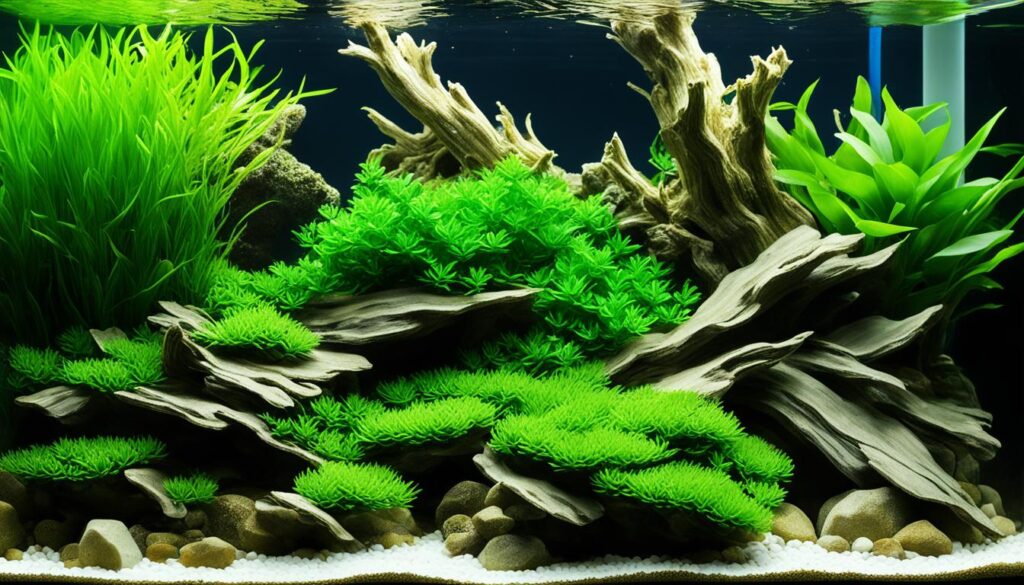
| Aragonite Substrate Benefits | Considerations |
|---|---|
| Increases pH for fish species that prefer higher pH levels | Excessive pH increase can be harmful to some fish species |
| Can be mixed with other substrates to achieve desired pH levels | Requires careful monitoring of pH levels |
| Stabilizes pH levels in freshwater tanks | Research and consult with experts to meet specific fish needs |
Vermiculite: Nutrient-Rich Substrate for Plants
Vermiculite is a versatile substrate composed of various minerals that provide essential nutrients for planted tanks. Its slow release of potassium and magnesium promotes optimal plant growth and development, making it an ideal choice for aquarium enthusiasts looking to create a thriving plant ecosystem.
When combined with gravel, vermiculite offers numerous benefits for aquatic plants. The gravel provides a stable foundation for plants to establish their roots, while the vermiculite disperses nutrients into the water column, allowing plants to absorb them effectively. This combination creates a dynamic environment that supports healthy plant growth and enhances the overall aesthetic appeal of the aquarium.
It’s important to select a high-quality brand of vermiculite specifically designed for aquarium use to ensure the safety of your fish and plants. These brands undergo rigorous testing to guarantee they are free from contaminants and will not negatively impact water quality or harm aquatic life.
When using vermiculite as a substrate, it’s advisable to follow the manufacturer’s instructions for proper usage and application. This includes properly rinsing the vermiculite before adding it to the aquarium and ensuring it is evenly distributed throughout the tank to provide consistent nutrient availability to all plants.
Overall, vermiculite is an excellent option for aquarium enthusiasts seeking to create lush, vibrant planted tanks. Its nutrient-rich composition and compatibility with gravel make it a valuable addition to any aquatic plant setup, ensuring the optimal growth and health of your plants.

Vermiculite Substrate Benefits
| Benefits | Description |
|---|---|
| Nutrient-rich | Slow release of potassium and magnesium enhances plant growth and vitality. |
| Root support | When combined with gravel, provides a stable foundation for plant roots. |
| Efficient nutrient dispersion | Disperses nutrients into the water column, allowing plants to absorb them effectively. |
| Aesthetic appeal | Creates a lush and vibrant underwater landscape in planted tanks. |
| High-quality assurance | Specifically designed for aquarium use to ensure safety and optimal plant growth. |
Peat Moss: Softening Water and Buffering pH
Peat moss is an excellent choice for freshwater aquariums as it offers multiple benefits, including softening water and buffering pH levels. Its natural properties make it a valuable substrate option for fish owners looking to create an optimal environment for their aquatic pets.
Before adding peat moss to your tank, it’s crucial to properly prepare it by soaking it in water. This process helps balance the pH and ensures that the peat moss is ready to create the desired water conditions in your aquarium.
There are two common ways to use peat moss in your tank:
- Substrate layer: By adding peat moss as a substrate layer, you allow it to gradually release tannins into the water, lowering the pH and creating a more acidic environment. This is particularly beneficial for fish species that thrive in soft, acidic water.
- Filter medium: You can also utilize peat moss as a filter medium. Simply place it in your aquarium filter, and as water flows through, the peat moss will further aid in softening the water and stabilizing the pH levels.
When selecting peat moss, it’s essential to choose an organic option that does not contain any added chemicals or fertilizers. This ensures the safety of your fish and prevents any harmful substances from entering the aquatic ecosystem.
It’s important to regularly monitor the pH levels in your tank when using peat moss. While peat moss effectively buffers pH, it’s crucial to maintain a stable environment for your fish. Regular testing and adjustments are key to ensure the water conditions remain suitable for your aquatic pets.
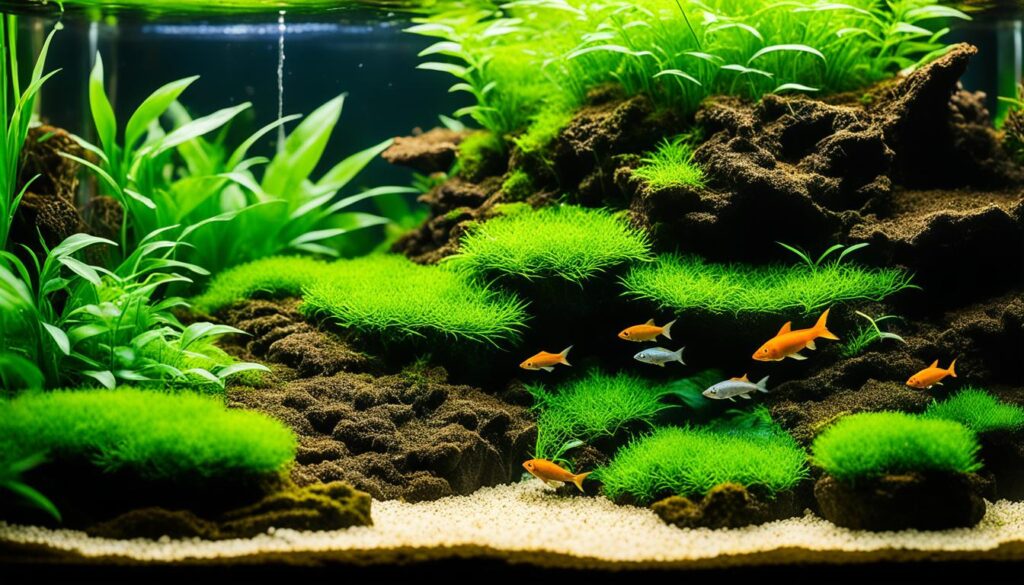
Comparison of Substrates for Softening Water
| Substrate | Softening Capability | pH Buffering | Suitable for Planted Tanks |
|---|---|---|---|
| Peat Moss | ✓ | ✓ | ✓ |
| Aragonite | ✓ | ✓ | ✗ |
| Vermiculite | ✗ | ✗ | ✓ |
“Using peat moss as a substrate not only softens the water, but it also buffers the pH, creating conditions that mimic the natural habitats of many freshwater fish species.” – AquaWorld Magazine
Coral: Controlling pH and Creating a Reef-like Environment
Crushed coral is a popular substrate choice for aquariums due to its ability to control pH levels and create a reef-like environment. It is commonly used in reef aquariums but can also benefit certain freshwater fish species that require high pH levels.
One such fish species that thrives in a crushed coral substrate is the Freshwater African cichlid. These cichlids naturally inhabit areas with rocky substrates, and the crushed coral provides them with a similar environment in captivity, promoting their overall well-being.
Adding crushed coral to your aquarium not only helps to maintain higher and stable pH levels but also contributes to the natural aesthetic of a coral reef. The substrate creates a visually appealing underwater landscape that mimics the beauty of the ocean.
Benefits of Coral Substrate:
- Controls pH: Crushed coral acts as a natural buffer, maintaining a higher pH level in your aquarium, which is crucial for fish species that thrive in alkaline conditions.
- Reef-like Environment: The coral substrate creates a visually stunning environment reminiscent of a coral reef, providing a natural and appealing habitat for your fish.
- Alleviates Stress: The natural surroundings created by the coral substrate can help reduce stress in fish, leading to happier and healthier aquatic life.
- Calcium Release: Coral substrates slowly release calcium ions into the water, promoting the growth of coral and other calcifying organisms in the aquarium.
When using crushed coral as a substrate, it’s essential to ensure that you are using the correct type specifically designed for aquarium use. Avoid substrates that may contain harmful additives or heavy metals that can be detrimental to your fish’s health.
Remember to monitor your aquarium’s pH levels regularly, as excessive levels can be harmful. Maintaining a stable and suitable environment is key to the well-being of your fish.

| Benefits of Coral Substrate | |
|---|---|
| Controls pH | Crushed coral acts as a natural buffer, maintaining a higher pH level in your aquarium, which is crucial for fish species that thrive in alkaline conditions. |
| Reef-like Environment | The coral substrate creates a visually stunning environment reminiscent of a coral reef, providing a natural and appealing habitat for your fish. |
| Alleviates Stress | The natural surroundings created by the coral substrate can help reduce stress in fish, leading to happier and healthier aquatic life. |
| Calcium Release | Coral substrates slowly release calcium ions into the water, promoting the growth of coral and other calcifying organisms in the aquarium. |
Conclusion
Choosing the right substrate for your freshwater aquarium is crucial in creating a healthy and visually appealing environment for your fish. There are several options to consider, including gravel, sand, soil, aragonite, vermiculite, peat moss, coral, marbles, and clay, each with its own benefits and considerations. When making a decision, take into account factors such as the species of fish, the size of your tank, and the presence of live plants.
Regularly monitoring water parameters and performing necessary maintenance is essential to ensure a safe and thriving aquarium environment for your fish. This includes testing and adjusting water pH levels as needed, as well as keeping a close eye on any changes in water quality. Regular water changes and the removal of any excess debris are also important for maintaining a healthy aquarium.
Remember to observe your fish and their behavior to ensure that they are comfortable and content in their environment. If you notice any signs of stress or illness, take prompt action and consult with a professional aquarist or veterinarian. By providing the right substrate and taking proper care of your freshwater aquarium, you can create a beautiful and enjoyable home for your fish.
FAQ
What is the best substrate option for a freshwater aquarium?
The best substrate option for your freshwater aquarium depends on factors such as tank size, fish species, and whether you have live plants. Gravel, sand, soil, aragonite, vermiculite, peat moss, coral, marbles, and clay are all viable options, each with its own advantages and considerations.
Is gravel a good choice for a freshwater aquarium?
Yes, gravel is one of the most popular substrate options for freshwater aquariums. It comes in a variety of colors and sizes, is aesthetically pleasing, and easy to clean. However, it’s important to choose gravel with smooth edges to avoid irritating fish with soft skin. It’s also recommended to add a nutrient-rich layer of aquarium soil under the gravel for planted tanks.
Why is sand a popular substrate option for freshwater aquariums?
Sand is another popular substrate option, especially in tanks with fish that prefer a natural habitat. It comes in different grain sizes and colors, is easy to clean, and doesn’t trap debris. Sand is ideal for bottom-dwelling fish and provides a natural look. It can also be mixed with other substrates for unique aquarium styles.
What is aquarium soil and why is it recommended for planted tanks?
Aquarium soil is specially formulated to stay solid underwater and is perfect for planted tanks. It provides a rich environment for plant growth and often contains added plant nutrients. Aquarium soil comes in natural brown colors and is a great choice for creating a lush and vibrant underwater landscape. However, it’s important to only use aquarium soil purchased from pet stores to ensure it is safe for your fish.
Can aragonite be used as a substrate for freshwater tanks?
Aragonite is a type of sand that consists of calcium carbonate. It slowly releases calcium carbonate into the water, which helps maintain higher pH levels. Aragonite is commonly used in reef aquariums but can also be used in freshwater tanks for fish species that prefer higher pH levels. It can be mixed with other substrates to achieve the desired pH level, but it’s important to monitor pH levels closely.
What are the benefits of using vermiculite as a substrate?
Vermiculite is a substrate that is a mixture of different minerals. It slowly releases potassium and magnesium, making it ideal for planted tanks. It works best when combined with gravel, providing plants with ample material to hold their roots and dispersing nutrients into the water. Vermiculite is a great option for creating a thriving plant ecosystem in your aquarium.
How can peat moss be used as a substrate for freshwater aquariums?
Peat moss can be used to naturally soften water and buffer pH levels. It needs to be properly prepared by soaking in water to balance the pH before adding it to the tank. Peat moss can be used as a substrate layer or as a filter medium to achieve the desired water conditions. It’s important to choose organic peat moss without added chemicals or fertilizers to ensure the safety of your fish.
Can crushed coral be used as a substrate for freshwater aquariums?
Yes, crushed coral is a substrate that can help maintain higher and steady pH levels in the tank. It is commonly used in reef aquariums but can also benefit certain freshwater fish species, such as African cichlids. However, it’s important to ensure that the crushed coral you use is specifically designed for aquarium use and doesn’t contain any harmful additives.
